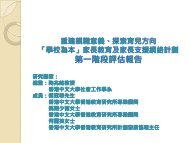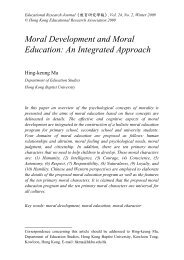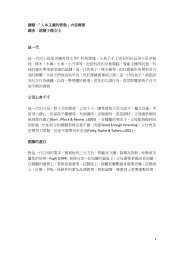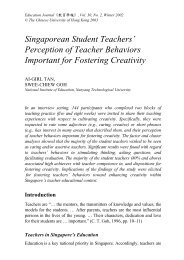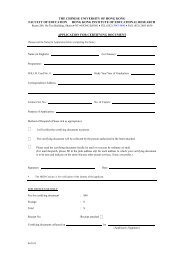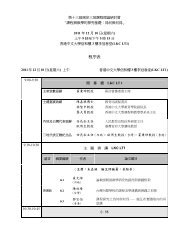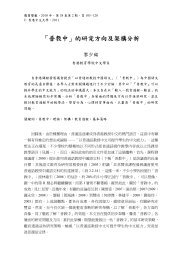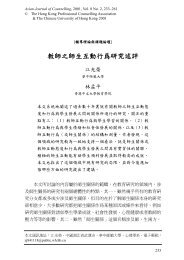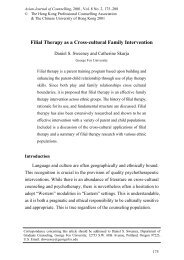Using School Evaluation Policy to Effect Curriculum Change? A ...
Using School Evaluation Policy to Effect Curriculum Change? A ...
Using School Evaluation Policy to Effect Curriculum Change? A ...
You also want an ePaper? Increase the reach of your titles
YUMPU automatically turns print PDFs into web optimized ePapers that Google loves.
Educational Research Journal《教育研究學報》, Vol. 25, No. 2, Winter 2010<br />
© Hong Kong Educational Research Association 2010<br />
<strong>Using</strong> <strong>School</strong> <strong>Evaluation</strong> <strong>Policy</strong><br />
<strong>to</strong> <strong>Effect</strong> <strong>Curriculum</strong> <strong>Change</strong>?<br />
A Reflection on the SSE and ESR<br />
Exercise in Hong Kong<br />
Shirley Sze-yin Yeung<br />
Department of <strong>Curriculum</strong> and Instruction<br />
The Hong Kong Institute of Education<br />
In Hong Kong, despite the officials’ efforts <strong>to</strong> reform the school<br />
curriculum, studies have found that implementation of the proposed<br />
changes has been superficial (Yeung, 2006, 2009). Recently, evidencebased<br />
school self-evaluation has become a global trend in the school<br />
improvement movement. The Education Bureau in Hong Kong has<br />
followed this trend and launched a school evaluation policy — <strong>School</strong><br />
Self <strong>Evaluation</strong> (SSE) and External <strong>School</strong> Review (ESR). The pair of<br />
evaluation measures was initiated <strong>to</strong> help schools <strong>to</strong> evaluate their own<br />
effectiveness, <strong>to</strong> ensure public accountability and <strong>to</strong> achieve self<br />
development (Quality Assurance Division, 2006). This paper shares the<br />
findings from a local research, which looks in<strong>to</strong> the perception of the<br />
policy by school curriculum leaders and its possible impact on the<br />
school curriculum and teachers. The curriculum leaders described both<br />
________________________<br />
Correspondence concerning this article should be addressed <strong>to</strong> Shirley Sze-yin<br />
Yeung, Department of <strong>Curriculum</strong> and Instruction, The Hong Kong Institute<br />
of Education, 10 Lo Ping Road, Tai Po, N.T., Hong Kong. E-mail:<br />
syyeung@ied.edu.hk
188 Shirley Sze-yin Yeung<br />
positive and negative effects, potential threats and weaknesses of the<br />
school evaluation policy. Specific attention was given <strong>to</strong> how effective<br />
school evaluation in effect makes curriculum reform manda<strong>to</strong>ry.<br />
Findings show how the local school curriculum can be controlled by<br />
bureaucratic preferences through SSE and ESR, and ultimately lost its<br />
ability <strong>to</strong> deal with diversity. It also shows how such forces impede<br />
teachers’ professional au<strong>to</strong>nomy and liberty.<br />
Key words: school evaluation, curriculum change, curriculum<br />
implementation<br />
Introduction<br />
Facing the challenges of globalization, technological development and<br />
social change, the Education Bureau in Hong Kong has revised the<br />
overall aims of education for the 21st Century (Education Commission,<br />
2000). Based on the revised educational aims, a curriculum reform was<br />
launched in 2001 (<strong>Curriculum</strong> Development Council, 2001). The<br />
curriculum reform is intended <strong>to</strong> offer a quality school curriculum that<br />
better equips students <strong>to</strong> meet the challenges of a knowledge-based,<br />
interdependent world. The recommendations stress the importance of<br />
helping students <strong>to</strong> learn how <strong>to</strong> learn, a learning-focused approach in<br />
teaching and curriculum construction, diversified curriculum and<br />
teaching strategies <strong>to</strong> suit the different needs of students, and so forth<br />
(<strong>Curriculum</strong> Development Council, 2001, pp. 10–11). To achieve the<br />
aims and visions of curriculum reform, schools and teachers are<br />
recommended <strong>to</strong> develop school-based curriculum <strong>to</strong> suit the needs of<br />
students. Moreover, teachers are strongly recommended <strong>to</strong> advance their<br />
teaching strategies <strong>to</strong>ward student-centered approaches.<br />
On paper, the curriculum reforms appear well designed, with<br />
recommendations that will help <strong>to</strong> prepare the next generation <strong>to</strong> live in<br />
a challenging century. However, despite the Education Bureau’s efforts<br />
<strong>to</strong> disseminate the reform proposals, local research shows that the<br />
reform is far from successful. For instance, findings from some local<br />
studies showed that teachers in Hong Kong implemented the studentcentered<br />
approach only superficially. <strong>Curriculum</strong> change and innovation,
<strong>School</strong> <strong>Evaluation</strong> <strong>Policy</strong> 189<br />
although promoted for years, are still far from affecting most classrooms<br />
(Yeung, 2006, 2009).<br />
Currently, evidence-based or outcome-based school self-evaluation<br />
has become a global trend in the school improvement movement. The<br />
Education Bureau (EDB) has also launched a pair of school evaluation<br />
policies — <strong>School</strong> Self <strong>Evaluation</strong> (SSE) and External <strong>School</strong> Review<br />
(ESR). This seems a responsive policy where the officials sit down <strong>to</strong><br />
work out a common goal with school practitioners — i.e., schools<br />
evaluate themselves, improve themselves continuously and develop<br />
themselves in<strong>to</strong> quality schools. This school evaluation policy has<br />
significant impact on schools in Hong Kong, in terms of school<br />
organization, school curriculum, classroom teaching, and so forth. The<br />
present research investigated the effect of this policy on school<br />
curriculum and the teaching profession. In particular it probed the<br />
impact, if any, of school evaluation on the implementation of the<br />
curriculum reform in schools.<br />
In Hong Kong, curriculum leaders are the most important figures in<br />
putting education policy in<strong>to</strong> practice in schools. They lead the school<br />
team of teachers <strong>to</strong> implement policy. For this reason, their opinions<br />
about school educational policy are most representative. This study<br />
therefore invited twelve curriculum leaders <strong>to</strong> share their perception<br />
about the policy. They were also invited <strong>to</strong> evaluate both the positive<br />
and negative effect of the school evaluation policy.<br />
<strong>School</strong> <strong>Evaluation</strong> and <strong>Curriculum</strong> <strong>Change</strong><br />
Accountability and school improvement continue <strong>to</strong> be major driving<br />
forces in the current decade (Marsh, 2009). To ensure quality in<br />
education, schools in many Western countries undergo various models<br />
of school evaluation (Janssens & van Amelsvoort, 2008). There are two<br />
main types of school evaluation — external and internal. Generally<br />
speaking, external evaluation acts as a quality control mechanism which<br />
guarantees “standards” and “benchmarks” are met by schools<br />
(Livings<strong>to</strong>n & McCall, 2005). Internal evaluation helps schools <strong>to</strong><br />
ensure accountability <strong>to</strong> the public (Nevo, 1995, 1997). <strong>School</strong>s in some<br />
countries experience external inspection; while schools in other
190 Shirley Sze-yin Yeung<br />
countries adopt more liberal kinds of self evaluation. In some places, as<br />
in Hong Kong, schools are encouraged <strong>to</strong> adopt a combination of<br />
internal (school self evaluation) and external modes of evaluation. In<br />
either case, schools involved usually follow an evidence-based and<br />
standard-based model <strong>to</strong> produce objective and valid evidence of school<br />
performance.<br />
In actual fact, evaluation has a significant role in curriculum change.<br />
As Morris and Adamson (2010) mention,<br />
Any useful and comprehensive evaluation of a school has <strong>to</strong> address<br />
questions related <strong>to</strong> the curriculum and it should be able <strong>to</strong> identify and<br />
recommend solutions <strong>to</strong> any curriculum problems. (p. 170)<br />
<strong>Evaluation</strong> has many faces and it works for different purposes in<br />
different occasions (Nevo, 1995). While school evaluation or school<br />
review is essential <strong>to</strong> scrutinize school quality, program evaluation<br />
serves <strong>to</strong> evaluate the effect of curriculum change (Hopmann, 2003;<br />
Nevo, 1995; Popham, 1993). At any rate, educa<strong>to</strong>rs agree that<br />
curriculum change needs <strong>to</strong> be informed by evaluation (Hopmann, 2003;<br />
Morris & Adamson, 2010; Tener, 2009; Wood, 2001). The literature<br />
contains various models and approaches of evaluation <strong>to</strong> assess the<br />
quality and effectiveness of curriculum innovations, new projects and<br />
programs (Popham, 1993; Stufflebeam, Madaus, & Kellaghan, 2000;<br />
Worthen & Sanders, 1987). There are diverse views of purposes about<br />
educational evaluation underlying different models. For instance, the<br />
goal-attainment model of evaluation functions <strong>to</strong> verify if the goals of<br />
curriculum change have been implemented (Smith & Tyler, 1942);<br />
whereas the CIPP (Context-Input-Process-Product) models can help<br />
providing information for judging curriculum decisions (Stufflebeam,<br />
2000). All in all, evaluation can serve <strong>to</strong> provide empirical evidences<br />
that contribute <strong>to</strong> decisions about curriculum change (Worthen &<br />
Sanders, 1987, p. 6). However, it is criticised that policy-makers or<br />
school administra<strong>to</strong>rs often fail <strong>to</strong> base curriculum change on evaluation,<br />
leading reform sometimes appears <strong>to</strong> be based mainly on “slogans,<br />
doctrine or political goals” rather than on “a sound research base”<br />
(Mayer, 2005, p. 68). In Hong Kong, “Government-initiated”
<strong>School</strong> <strong>Evaluation</strong> <strong>Policy</strong> 191<br />
curriculum reforms are often problematic for teachers because they are<br />
found <strong>to</strong> be “political, complex, contradic<strong>to</strong>ry, and (occasionally)<br />
symbolic” (Morris & Adamson, 2010, p. 180). The selection of<br />
innovations rarely base on evaluation. Quite the reverse, findings from<br />
the present study demonstrate how the school evaluation policy<br />
facilitates the implementation of those government-initiated curriculum<br />
change.<br />
A Brief Account of <strong>School</strong> <strong>Evaluation</strong> <strong>Policy</strong> in Hong Kong<br />
In Hong Kong, the Education Commission issued the Education<br />
Commission Report No. 7 (Education Commission, 1997) in which a<br />
number of recommendations were formulated <strong>to</strong> improve school<br />
performance <strong>to</strong>wards provision of “quality school education”. Among<br />
the recommendations, school evaluation became the most influential. As<br />
a consequence, the Education Department introduced a quality<br />
assurance framework in September 1997. In this framework, Quality<br />
Assurance Inspection (QAI) served as an external QA mechanism while<br />
schools were required <strong>to</strong> conduct school self-evaluation (SSE) as an<br />
internal QA process. From 2003–2004, QAI was replaced by the <strong>School</strong><br />
Self evaluation (SSE) and External <strong>School</strong> Review (ESR). By <strong>School</strong><br />
Self <strong>Evaluation</strong>, schools could evaluate their own performance, improve<br />
themselves continuously and develop themselves in<strong>to</strong> quality schools.<br />
Following a school’s SSE, the Education Bureau (EDB) conducts<br />
External <strong>School</strong> Review (ESR) of public sec<strong>to</strong>r schools <strong>to</strong> validate<br />
schools’ self evaluation (SSE). In this way, ESR plays a complementary<br />
role <strong>to</strong> SSE. It is an external evaluation <strong>to</strong> scrutinize internal evaluation<br />
(SSE) carried out in schools.<br />
To support SSE and ESR, a framework of Performance Indica<strong>to</strong>rs<br />
(PI) was provided <strong>to</strong> help stakeholders <strong>to</strong> assess school performance.<br />
<strong>School</strong>s are required <strong>to</strong> conduct a holistic review with reference <strong>to</strong> the<br />
Performance Indica<strong>to</strong>rs framework. The ESR procedures also use this<br />
framework <strong>to</strong> consider how schools perform and self-evaluate. Both<br />
procedures seek <strong>to</strong> review school development and effectiveness. The<br />
framework of PIs is composed of four domains containing 29 PIs<br />
(Quality Assurance Division, 2002). The four domains include
192 Shirley Sze-yin Yeung<br />
management and organization, learning and teaching, student support<br />
and school ethos, and student performance.<br />
To facilitate the schools’ self-evaluation process, the EDB has<br />
developed Key Performance Measures (KPM) and measurement <strong>to</strong>ols<br />
such as Standard Stakeholder Survey questionnaires (Education Bureau,<br />
2009). <strong>School</strong>s are expected <strong>to</strong> use these instruments for self assessment<br />
of school performance.<br />
By 2008, the framework of PIs had been trimmed down <strong>to</strong> 23 PIs.<br />
Other evaluation <strong>to</strong>ols provided by the Bureau, such as KPM, have also<br />
been revised in order <strong>to</strong> “enable schools <strong>to</strong> review their work in a more<br />
effective and focused manner that will ultimately enhance the<br />
effectiveness of SSE” (Quality Assurance Division, 2008,<br />
p. 1).<br />
Generally, a school will undergo one cycle of SSE and ESR every<br />
three <strong>to</strong> four years. In actual implementation of ESR, an “ESR team”<br />
(composed of EDB officials, and one external reviewer) visits a school<br />
for up <strong>to</strong> five days (known as the ESR week). On paper, the ESR team is<br />
required <strong>to</strong> operate in ways that ensure the external inspection process is<br />
independent, responsive, fair and open. All procedures are <strong>to</strong> be<br />
available <strong>to</strong> school personnel and school boards. Discussion and<br />
communication between schools and officials is encouraged. However,<br />
the performance ratings of individual teachers remain confidential. A<br />
formal ESR report will be prepared and given <strong>to</strong> the school. The school<br />
has <strong>to</strong> release the ESR findings <strong>to</strong> stakeholders such as the <strong>School</strong><br />
Management Committee, teachers and parents.<br />
Research Purpose and Methods<br />
The key purpose of this research is <strong>to</strong>:<br />
1. understand the perception of school practitioners <strong>to</strong>ward SSE and<br />
ESR and the approach they take in response; and<br />
2. reveal the underlying agenda or effect, if any, of this policy on the<br />
development of schools, their curriculum and teachers.<br />
Interviewing was the major research method used in this study.<br />
Interviewing is an effective method <strong>to</strong> probe the subjective feeling of
<strong>School</strong> <strong>Evaluation</strong> <strong>Policy</strong> 193<br />
key participants (Weiss, 1994). This study invited twelve participants of<br />
a course, namely the “Training Programs for Primary <strong>School</strong><br />
<strong>Curriculum</strong> Leaders 2008/2009” commissioned by the Education<br />
Bureau, <strong>to</strong> participate in the study. These curriculum leaders are<br />
experienced primary school teachers in Hong Kong and have been<br />
leading the development of school curriculum for years. They were<br />
required <strong>to</strong> attend the Training Program when newly appointed as<br />
Primary <strong>School</strong> Masters (<strong>Curriculum</strong> Development), 1 PSMCDs in<br />
abbreviation. These twelve PSMCDs were particularly invited because<br />
their schools were recently inspected by ESR. The researcher thought<br />
their experiences from this school evaluation exercise were therefore<br />
most fresh and relevant. Their experience and perspectives are essential<br />
<strong>to</strong> this study. PSMCDs are also teachers in schools, who are expected <strong>to</strong><br />
lead their school’s teachers in planning for and coping with the<br />
requirements of SSE and ESR. Semi-structured individual interviews,<br />
each around one hour, were conducted. The researcher asked each of the<br />
curriculum leaders about their perspectives and perception of SSE and<br />
ESR. One key focus was <strong>to</strong> look in<strong>to</strong> how these leaders perceived the<br />
influence of school evaluation on their curriculum and leadership role.<br />
Interview questions included:<br />
1. What do you think the purpose(s) of SSE and ESR are?<br />
2. How does SSE and ESR affect the school, the teachers and you?<br />
3. How do the school and you respond <strong>to</strong> the school evaluation policy?<br />
4. How has SSE and ESR influenced the curriculum development,<br />
teaching, and leadership in your school?<br />
All interviews were transcribed, followed by qualitative data<br />
analysis. To analyse qualitative data collected by interviews, “inductive<br />
analysis” was employed (Pat<strong>to</strong>n, 2002). The researcher identified and<br />
discovered patterns, themes and trends that emerged from the data.<br />
Major Research Findings<br />
This research procedure helped the researcher <strong>to</strong> probe the participants’<br />
perspectives and perceptions about SSE and ESR. Qualitative analysis<br />
started after the collection of interviewing data. During the process of
194 Shirley Sze-yin Yeung<br />
identifying, coding and categorizing, patterns (recurring regularities)<br />
emerged from the data. These patterns were represented by the<br />
following broad themes:<br />
1. SSE/ESR and curriculum reform<br />
2. SSE/ESR and the achievement-oriented tradition in Hong Kong<br />
3. Teachers’ coping strategies for SSE/ESR<br />
4. SSE/ESR and diversity in classrooms<br />
The following sections analyse these findings in greater detail.<br />
SSE/ESR and <strong>Curriculum</strong> Reform<br />
All twelve curriculum leaders said that ESR and SSE aligned with the<br />
reform agenda stated in the official curriculum (<strong>Curriculum</strong><br />
Development Council, 2001). Many of them recognized the possibility<br />
that the officials used the school evaluation policy <strong>to</strong> mandate<br />
curriculum change. A few curriculum leaders said that by ESR, the<br />
officials help schools develop professionally. They described the policy<br />
as an “inevitable external force” <strong>to</strong> push teachers <strong>to</strong> improve teaching<br />
and learning.<br />
I think that ESR is a kind of “force” that helps push us (schools) <strong>to</strong> put<br />
curriculum reform in<strong>to</strong> practice. It is clear that the curriculum reform items<br />
are criteria for measuring a school’s effectiveness. (CD 9: 11–12)<br />
We found that the framework that schools are asked <strong>to</strong> follow in preparing<br />
for SSE and ESR is the same with that proposed in current curriculum<br />
reform — for example, our teaching is expected <strong>to</strong> enhance students’<br />
generic skills such as communication, critical and creative thinking, etc.<br />
We need <strong>to</strong> design tasks or activities <strong>to</strong> assess formatively the learning<br />
progress of students. (CD 6: 58–61)<br />
Two curriculum leaders (CD 9, CD2) said that it is the purpose of<br />
ESR <strong>to</strong> check and push teachers <strong>to</strong> improve their teaching.<br />
I think the EDB wishes <strong>to</strong> use ESR as a means <strong>to</strong> make teachers change<br />
their way of teaching. This is especially a critical measure for those who are<br />
used <strong>to</strong> the conventional type of teaching. (CD 9: 10–15)
<strong>School</strong> <strong>Evaluation</strong> <strong>Policy</strong> 195<br />
SSE/ESR and the Achievement-oriented Tradition in Hong Kong<br />
It is a matter of fact that the perspective of the public (parents, especially)<br />
tends <strong>to</strong> be utilitarian. Parents try <strong>to</strong> send their children <strong>to</strong> <strong>to</strong>p schools.<br />
Results in public examinations are the main indica<strong>to</strong>r of a <strong>to</strong>p school.<br />
<strong>Curriculum</strong> leaders in this study reflected that both principals and<br />
parents cared very much whether their schools could out-perform others<br />
in ESR. ESR report is like a “report card” issued <strong>to</strong> a school. There are<br />
kinds of “league table” between schools in the districts. Parents would<br />
compare ESR reports among schools.<br />
Our school principal cares very much where the place our school is on the<br />
somewhat informal “league table” between schools in the district. The<br />
informal league table derives from parents’ estimation. You couldn’t<br />
imagine how parents make this happen. From ESR report issued <strong>to</strong> the<br />
school, parents could find comments of the officials made about our school.<br />
ESR report is like a “report card” issued <strong>to</strong> a school. Parents also equate the<br />
achievement of a school <strong>to</strong> its ability <strong>to</strong> send students <strong>to</strong> eminent secondary<br />
schools. (CD 2: 60–68)<br />
<strong>Curriculum</strong> leaders found they could not ignore the power of the “league<br />
table”,<br />
Indeed, the EDB has its own “league table”, which is shown only <strong>to</strong> the<br />
school principal. The official league table is based heavily on TSA 2 results.<br />
The principal will ask me and other leaders <strong>to</strong> follow up if our school does<br />
not get a favorable place on the league table. (CD 2, 70–75)<br />
Indeed, the ESR officials expects <strong>to</strong> see how a school responds <strong>to</strong> its<br />
place in this league table,<br />
TSA result is one key component in SSE report. We need <strong>to</strong> analyse the<br />
student achievement shown on TSA, then identify the strengths and<br />
weaknesses <strong>to</strong> draft our school improvement plan. The ESR officials will<br />
then review how our school performs data analysis, self evaluation and<br />
planning according <strong>to</strong> the TSA result. (CD 2: 146–150)<br />
However assertive the officials sound when they promote the notion of<br />
“all-round education” <strong>to</strong> the public, the curriculum leaders find that the<br />
hidden agenda is still results-oriented.
196 Shirley Sze-yin Yeung<br />
Teachers’ Coping Strategies for SSE/ESR<br />
All the curriculum leaders agreed that schools had developed strategies<br />
<strong>to</strong> deal with the demand of ESR. These included: teachers work in<br />
collaboration <strong>to</strong> overcome difficulties, forming “study groups”, planning<br />
and acting <strong>to</strong> meet standards laid down by the Performance Indica<strong>to</strong>rs,<br />
and preparing teachers <strong>to</strong> cope with classroom observation.<br />
Collaborate <strong>to</strong> overcome difficulties<br />
Some curriculum leaders claimed that teachers mostly perceive ESR as a<br />
tactic used by EDB <strong>to</strong> moni<strong>to</strong>r their work. In order <strong>to</strong> equip the whole<br />
school well for the evaluation, people in a school work <strong>to</strong>gether. And the<br />
curriculum leaders mention that “cooperation and collaboration” is one<br />
most salient coping strategy. Many curriculum leaders see this as the<br />
positive effect of ESR,<br />
You couldn’t imagine how school teachers become united nowadays. All at<br />
once the ESR becomes a common goal for teachers <strong>to</strong> fight against.<br />
Previously some teachers preferred staying aloof or alone; now they see the<br />
need <strong>to</strong> work <strong>to</strong>gether. (CD 11: 45–48)<br />
Forming “study groups” <strong>to</strong> have in-depth understanding of the evaluation<br />
guidelines<br />
Facing the challenge of ESR, several curriculum leaders spelled out<br />
their belief that sharing responsibilities among colleagues is a useful<br />
strategy.<br />
CD 1 shared that his school formed teachers in<strong>to</strong> “study groups” <strong>to</strong><br />
read carefully the ESR guidelines,<br />
We would form in<strong>to</strong> different study groups, each take turns <strong>to</strong> study ESR<br />
domains (like curriculum and teaching, assessment of student learning).<br />
Action plans will be prepared and submitted for review by the principal.<br />
(CD 1: 200–206)
<strong>School</strong> <strong>Evaluation</strong> <strong>Policy</strong> 197<br />
Working <strong>to</strong> the Performance Indica<strong>to</strong>rs<br />
Some curriculum leaders said that they would deliberate carefully on<br />
ways <strong>to</strong> work <strong>to</strong> the standards set by EDB. The PIs (The brief form<br />
which the curriculum leaders called “Performance Indica<strong>to</strong>rs”) are taken<br />
by the curriculum leaders as official standards for schools in Hong Kong<br />
<strong>to</strong> strive for (Quality Assurance Division, 2008). Together with school<br />
teachers, they study the PIs carefully and look for ways <strong>to</strong> achieve the<br />
standards stipulated in these PIs.<br />
Prepare teachers <strong>to</strong> cope with classroom observation<br />
Many school teachers and curriculum leaders are aware that observation<br />
of teaching is most important <strong>to</strong> reflect school effectiveness. For this<br />
reason, they derive different coping strategies <strong>to</strong> ensure better teaching<br />
performance can be shown <strong>to</strong> the ESR reviewers. These coping<br />
strategies include: studying the ESR’s assessment criteria of classroom<br />
teaching, improve personal teaching by peer observations, and so forth.<br />
For instance, some schools study the ESR’s criteria used <strong>to</strong> assess<br />
teachers’ teaching,<br />
We therefore form in<strong>to</strong> groups <strong>to</strong> study carefully ESR’s assessment criteria<br />
of classroom teaching. We find that the “observation record form for<br />
teaching performance” 3 is very useful. We therefore carefully look in<strong>to</strong> the<br />
assessment items on the record form, brains<strong>to</strong>rm ideas and experiences in<br />
putting those requirements in<strong>to</strong> effect. (CD 3: 44–48)<br />
The next thing is <strong>to</strong> improve their teaching methods,<br />
Therefore, I often remind my colleagues (teachers) <strong>to</strong> “polish” their<br />
teaching skills, train up the routine in classrooms, prepare their students <strong>to</strong><br />
work in groups, etc. All these preparation could help them (teachers) <strong>to</strong> get<br />
good grades when the ESR team arrives <strong>to</strong> observe their teaching in<br />
classrooms. (CD 10: 67–70)<br />
Besides, most schools conduct peer observation (of teaching), which is a<br />
useful way for teachers <strong>to</strong> view others’ teaching, <strong>to</strong> learn from each
198 Shirley Sze-yin Yeung<br />
other and <strong>to</strong> improve their own teaching. Some of these schools invited<br />
experts <strong>to</strong> hold a workshop or professional development day/retreat so<br />
that teachers can refresh their pedagogical knowledge. One school<br />
employs an external organization, which publicizes itself as capable in<br />
providing professional service <strong>to</strong> accelerate quality of school education,<br />
<strong>to</strong> model classroom observation for every teacher before ESR team<br />
arrives. The company observed every teacher’s teaching, analysed<br />
possible problems, then provided expert opinions <strong>to</strong> improve the<br />
school’s classroom teaching.<br />
SSE/ESR and Diversity in Classrooms<br />
One curriculum leader shared a noteworthy comment — the officials<br />
appear <strong>to</strong> pay little heed <strong>to</strong> individual differences in education but<br />
expect schools <strong>to</strong> make all students attain equally good academic<br />
achievement,<br />
It is quite disappointing <strong>to</strong> find that the ESR team seems <strong>to</strong> overlook the<br />
issue of diversity in classrooms in their comment on our school<br />
performance. They complained that our academic results in some cases<br />
were unsatisfac<strong>to</strong>ry; but they disregarded the fact that our school has<br />
admitted many students who have special needs (such as cases of mild<br />
mentally retarded, or other physically handicapped). Many of our students<br />
are from families of low SES [socioeconomic status]. How incoherent the<br />
officials sound in implementing educational policy! (CD 8: 105–112)<br />
Discussion<br />
Taking a Defensive Approach <strong>to</strong> Cope with the <strong>School</strong> <strong>Evaluation</strong><br />
<strong>Policy</strong><br />
This study shows that curriculum leaders and their school teachers <strong>to</strong>ok<br />
a careful approach <strong>to</strong> cater for the demand of ESR. Although the<br />
officials often reassure the school personnel that ESR is a friendly<br />
device <strong>to</strong> assist school development, in actual fact schools often take a
<strong>School</strong> <strong>Evaluation</strong> <strong>Policy</strong> 199<br />
defensive strategy <strong>to</strong> prepare for the ESR. From the major research<br />
findings, their skeptical stance can be clearly identified:<br />
1. taking ESR as a common difficulty or “hurdle” <strong>to</strong> be tackled, the<br />
curriculum leaders had derived with school teachers various coping<br />
strategies, these included collaborative planning, forming “think<br />
tanks” or “study groups”, professional development of teachers <strong>to</strong><br />
enhance quality teaching, etc.;<br />
2. perceiving that classroom observation is one key focus of ESR, the<br />
curriculum leaders devised ways <strong>to</strong> enhance quality of teaching in<br />
classrooms, such as initiating peer observation of teaching,<br />
organizing teacher development workshop.<br />
Obviously, the study showed that many curriculum leaders<br />
interpreted the policy as a bureaucratic or managerial tactic. Although<br />
the curriculum leaders did not dispute that SSE and ESR helped their<br />
schools in some ways, the attitude taken was one of “problemtackling”<br />
— the target is <strong>to</strong> report school achievement <strong>to</strong> the central<br />
authority. For this reason, schools were keen <strong>to</strong> pursue effective “coping<br />
strategies”, often preparing substantial quantitative evidence. Many even<br />
put aside other essential duties (such as talking with students), and work<br />
<strong>to</strong> the expectation of the officials as well as the demand of parents. This<br />
stress on documentation in turn brought great pressure and workload on<br />
teachers. As some curriculum leaders in this study said, “many teachers<br />
worried that their teaching couldn’t get a good grade in ESR and this<br />
would affect the rating of the school” (CD 8: 90–91). In this way,<br />
teachers become “mere technicians, instruments and deliverers of other<br />
people’s agendas” (Hargreaves, 2003, p. 161). Eventually, teachers in<br />
our community have little capacity <strong>to</strong> recapture their dignity and act as,<br />
in Hargreaves’ word, “the society’s leading intellectuals (p. 161)”.<br />
Teaching is reduced <strong>to</strong> technical rationality and teachers do not become<br />
truly reflective, professional practitioners (Schön, 1983). Eisner (2001)<br />
severely criticized this as “a culture of schooling in which a narrow<br />
means/ends orientation is promoted” (p. 187). He reminded that<br />
excessive focus on this orientation would make educational practitioners<br />
leave the deeper problems of schooling and the real meaning of<br />
education unattended.
200 Shirley Sze-yin Yeung<br />
EDB <strong>Effect</strong>s <strong>Curriculum</strong> <strong>Change</strong> by ESR<br />
The research findings show how curriculum leaders agreed that the SSE<br />
and ESR framework was a prevailing force that compels teachers <strong>to</strong><br />
implement faithfully the planned, official curriculum reform in<br />
classrooms.<br />
It is obvious that because of the impact of SSE and ESR, schools<br />
were more eager <strong>to</strong> implement the imposed curriculum reform. Listed<br />
below are two instances found from the study:<br />
1. As mentioned, the curriculum leaders found that school teachers<br />
become more collaborative in view of the need <strong>to</strong> tackle the<br />
challenge posed by ESR. For the same reason, more peer<br />
observation and more teacher development workshops are<br />
undertaken. These can be said <strong>to</strong> be a promising effect of school<br />
evaluation. It is noteworthy that such development matches with the<br />
EDB’s policy intent <strong>to</strong> enhance local school collaborative culture as<br />
well as teacher development (see <strong>Curriculum</strong> Development Council,<br />
2001).<br />
2. The findings showed that teachers studied carefully the EDB’s<br />
“observation record form for teaching performance” <strong>to</strong> improve<br />
their teaching. The record form designed for observing teachers’<br />
teaching lists criteria which are coherent with key proposals of local<br />
curriculum reform (e.g., student-teacher interaction, nine generic<br />
skills, curriculum integration, IT in education, etc.). So, when<br />
school teachers refer their teaching closely <strong>to</strong> such criteria, they will<br />
eventually shift from the conventional way <strong>to</strong> a more studentcentered<br />
one.<br />
<strong>Curriculum</strong> leaders said that schools were particularly willing <strong>to</strong><br />
work in compliance with the official recommendation when they faced<br />
difficulty in recruiting enough students. Some participants and their<br />
schools even interpreted the policy as a political tactic and related it <strong>to</strong><br />
decisions on school closure. Hence, it is not strange that schools are<br />
making greater efforts <strong>to</strong> ensure maximum congruency and alignment<br />
between the school plan and the official, planned curriculum.
<strong>School</strong> <strong>Evaluation</strong> <strong>Policy</strong> 201<br />
Mandating <strong>Curriculum</strong> <strong>Change</strong> by the Framework of Performance<br />
Indica<strong>to</strong>rs<br />
The Performance Indica<strong>to</strong>rs (PIs) are used in ESR as reference <strong>to</strong><br />
evaluate school performance under four domains of school work. This<br />
study found that many of the schools involved <strong>to</strong>ok the PIs as a checklist<br />
of their school’s practice. Some of the schools organized think-tanks <strong>to</strong><br />
study the PIs. Obviously, PIs have become “standards” for schools.<br />
They have turned out <strong>to</strong> be forceful means <strong>to</strong> mandate curriculum<br />
change.<br />
However, it must be added that although “standards” have<br />
considerable potential for improving schools, they can lead <strong>to</strong> an<br />
increased degree of centralized control over school curriculum,<br />
schooling and even the profession of teaching. There has been much<br />
criticism of the tendency <strong>to</strong> overuse or misuse PIs, particularly when it<br />
produces a ruthless pursuit of market competition. Hargreaves and Fink<br />
(2006, pp. 12–13) summarizes the following effects brought about by<br />
the pervasive spread of “standardization”:<br />
1. Narrowed the curriculum and destroyed classroom creativity<br />
2. Restricted innovative schools<br />
3. Widened the learning gap between elite and other schools<br />
4. Encouraged cynical and calculated strategies for raising test scores<br />
5. Undermined teacher confidence and competence<br />
6. Eroded professional community as teachers have <strong>to</strong> struggle alone<br />
<strong>to</strong> get through the overwhelming range of reform requirement<br />
7. Increased rate of stress, resignation and non-retention<br />
8. Instigated and amplified resistance <strong>to</strong> change<br />
Giving <strong>to</strong>o much weight <strong>to</strong> PIs could subject the profession of<br />
teaching <strong>to</strong> the routines of “soulless standardization” (Hargreaves, 2003,<br />
p. 82). Teachers and schools would be squeezed in<strong>to</strong> the “tunnel vision”<br />
of test scores and achievement targets (PIs) (p. 1). As a result teachers<br />
could lose opportunities <strong>to</strong> explore creative teaching, and their<br />
professional au<strong>to</strong>nomy.
202 Shirley Sze-yin Yeung<br />
Overstating Academic Achievement Undermines the <strong>Effect</strong>s of<br />
<strong>Curriculum</strong> Reform<br />
The study disclosed that the EDB was again found <strong>to</strong> be rhe<strong>to</strong>rical with<br />
their policy formulation and implementation. On one hand, the officials<br />
advocate “whole person education”; on the other hand, schools are<br />
evaluated on their ability <strong>to</strong> score good academic results, for example in<br />
the Terri<strong>to</strong>ry-wide System Assessment (TSA). Therefore, schools were<br />
keen <strong>to</strong> boost the results of their students in public examinations, rather<br />
than focusing on developing students’ capacity for learning <strong>to</strong> learn (a<br />
slogan of Hong Kong’s curriculum reform, <strong>Curriculum</strong> Development<br />
Council, 2001). Thus, the performance-oriented nature of ESR fortifies<br />
the quantitative, examination-oriented tradition of the educational<br />
context in Hong Kong (Biggs, 1996).<br />
This orientation would bring down the ideal of the curriculum<br />
reform. If assessment is used <strong>to</strong> determine individual competence, old<br />
values of community, cooperation, individual need and equal worth<br />
would be replaced by values that celebrate individualism, performativity<br />
and differentiation (Ball, Bowe, & Gewirtz, 1994). This is in opposition<br />
<strong>to</strong> the values of the renewed curriculum (<strong>Curriculum</strong> Development<br />
Council, 2001), which specifies moral values as one essential aim for<br />
reform.<br />
In reality, findings from this research show that teachers and<br />
curriculum leaders have become more goal-oriented as the education<br />
enterprise, under the influence of ESR, becomes defined in terms of<br />
output (PIs, test results) rather than process. The danger of “teaching <strong>to</strong><br />
the test” would, quite contrary <strong>to</strong> what is expected in the curriculum<br />
reform, diminish the quality of teaching. The researcher did hear from<br />
curriculum leaders that teachers were willing <strong>to</strong> change their way of<br />
teaching in times of ESR. However, one curriculum leader said,<br />
“Teachers would not sustain this because they are clear that preparing<br />
students <strong>to</strong> surpass others in tests and examinations is more important”<br />
(CD 12: 76–78 ).
<strong>School</strong> <strong>Evaluation</strong> <strong>Policy</strong> 203<br />
EDB Shapes a Homogeneous <strong>Curriculum</strong> for the Society<br />
Findings from this study revealed how EDB steers the implementation<br />
of curriculum reform proposal through its school evaluation policy in all<br />
schools in Hong Kong; as a consequence, the curriculum implemented<br />
school-by-school is virtually homogeneous. The curriculum disregards<br />
individual differences and diversity of learning needs in the classrooms.<br />
This opinion was reflected by curriculum leaders. Hence, the same<br />
curriculum is generally delivered <strong>to</strong> all students in Hong Kong<br />
classrooms.<br />
Furthermore, ESR promotes comparison and commensurability<br />
among schools and provides a means for the officials and the parents <strong>to</strong><br />
exercise control over school curriculum. Certainly, parents’<br />
understanding of quality school curriculum is shaped by the officials’<br />
consistent education (through media and propaganda). Hence, <strong>to</strong> make<br />
their schools more competitive, teachers have <strong>to</strong> be pragmatic with their<br />
approach in their curriculum planning. They need <strong>to</strong> work <strong>to</strong> the official<br />
standards and also the expectation of parents. The official curriculum<br />
agenda is thus faithfully put in<strong>to</strong> practice. This again leads <strong>to</strong> inability <strong>to</strong><br />
deal with diversity in school curriculum, which is a threat <strong>to</strong> egalitarian<br />
ideals (Apple, 2006; Whitty, Power, & Halpin, 1998). The group of<br />
disadvantaged, lower-achievers in the classroom, is not supported by<br />
local education. This problem is found in many countries, in which,<br />
the market did not encourage diversity in curriculum, pedagogy,<br />
organization, clientele, or even image. It instead consistently devalued<br />
alternatives and increased the power of dominant models. Of equal<br />
significance, it also consistently exacerbated differences in access and<br />
outcome based on race, ethnicity and class. (Apple, 2000, p. 92)<br />
Conclusion<br />
This study shows how the school evaluation policy in Hong Kong<br />
functions <strong>to</strong> become one effective <strong>to</strong>ol imposed by the EDB <strong>to</strong> push
204 Shirley Sze-yin Yeung<br />
forward its proposals of curriculum reform. Eisner (2001) once<br />
describes this kind of practice by the concept of rationalization. He<br />
elaborates that rationalization has a number of features. By comparison,<br />
it is found that ESR and SSE actually displays many of these features,<br />
for instance:<br />
1. it depends on a clear specification of intended outcomes — i.e.,<br />
what standards and rubrics (PIs) are supposed <strong>to</strong> do;<br />
2. it uses measurement and assessment as a means through which the<br />
quality of a product or performance is assessed and represented;<br />
3. it is predicated on the ability <strong>to</strong> control and predict — it enables the<br />
government <strong>to</strong> control or moni<strong>to</strong>r how schools perform and <strong>to</strong><br />
which extent the curriculum standards are met;<br />
4. it promotes comparison and commensurability — in the community<br />
of Hong Kong, schools are currently compared by the parents, ESR<br />
facilitates this process. (Eisner, 2001, pp. 184–186)<br />
This allows the government <strong>to</strong> mandate and direct officially<br />
designed curriculum change (<strong>Curriculum</strong> Development Council, 2001).<br />
Besides, the formulation of standards and the measurement of<br />
performance are ways <strong>to</strong> make teachers and schools more accountable <strong>to</strong><br />
the public. Consequently the government could maintain efficiency and<br />
effectiveness of local education. However, it will be sad if the<br />
community is pursuing one set of standards and a homogenous<br />
curriculum, which is mainly manipulated by a central agency. And this<br />
also threatens the professional au<strong>to</strong>nomy of teachers.<br />
Moreover, this study reflects how school curriculum in Hong Kong<br />
experiences the combined force of bureaucratic control and consumer<br />
choice. Interviewees mentioned that school survival required parental<br />
support. Parents therefore could influence and moni<strong>to</strong>r the direction of<br />
local educational development. Obviously the government understands<br />
this and by way of public propaganda, officials easily mould the values<br />
of parents. Hence, the EDB uses its bureaucratic power as well as<br />
consumer power <strong>to</strong> take away the professional control of education from<br />
teachers. Teachers have <strong>to</strong> give way <strong>to</strong> “consumer choice” as well as<br />
bureaucratic control. This kind of bureaucratic accountability in<br />
education impedes professional development of the community (O’Day,
<strong>School</strong> <strong>Evaluation</strong> <strong>Policy</strong> 205<br />
2002). Of course, some may even say that it signifies mistrust for<br />
teachers as well as a threat <strong>to</strong> the professional au<strong>to</strong>nomy of teachers.<br />
Apple (2006) writes that under this condition, teachers are given only<br />
kinds of “regulated au<strong>to</strong>nomy”, when “teachers’ actions are now subject<br />
<strong>to</strong> much scrutiny in terms of process and outcomes… such a regime of<br />
control is based not on trust, but on a deep suspicion of the motives and<br />
competence of teachers” (p. 43). Obviously, in a democratizing society<br />
like Hong Kong, one would not expect that teachers are deprofessionalized<br />
in ways that “only legitimate content and methods are<br />
(allowed <strong>to</strong> be) taught” (p. 43).<br />
Despites all efforts so taken, evidence in this study showed that the<br />
effect brought by this school evaluation policy on local curriculum<br />
reform is still superficial. Fundamental principles of the curriculum<br />
reform (<strong>Curriculum</strong> Development Council, 2001) — such as catering for<br />
individual differences, advancing the quality of teaching and learning,<br />
and professionalizing the teaching profession — are not thoroughly<br />
followed up during ESR.<br />
All in all, there is a principle or rule of change — “an organization<br />
does not change until the individuals within it change” (Hall & Hord,<br />
2006). Educational change is not just a matter of successful or<br />
unsuccessful implementation of innovations but more basically and<br />
importantly a change in the profession of teaching, and the institutions<br />
in which teachers are trained and in which they work (including<br />
schools). Bureaucratic moni<strong>to</strong>ring could hardly foster real change. Just<br />
as Fullan (1993) said, “you can’t mandate what matters” (p. 21).<br />
McLaughlin (1987) once argues that implementation of curriculum<br />
change is not about transmitting <strong>to</strong>p-down policy by political or<br />
technical strategies (see also House, 1979), but about bargaining,<br />
negotiating and transformation. Experience suggests that<br />
implementation with a “cultural” perspective that emphasizes cultural<br />
transformation as a major fac<strong>to</strong>r is more successful. Implementation<br />
must be framed in terms of individual ac<strong>to</strong>rs’ incentives, beliefs and<br />
capacities (Lewis, 1988). Obviously, curriculum reform in Hong Kong<br />
has rarely given adequate consideration <strong>to</strong> these fac<strong>to</strong>rs (see also Yeung<br />
& Lam, 2007). <strong>Policy</strong>-makers could refer <strong>to</strong> Astu<strong>to</strong>, Clark, Read,<br />
McGee, & Fernandez’s (1994) ten basic shifts in beliefs, policies and
206 Shirley Sze-yin Yeung<br />
practices, which are said <strong>to</strong> be necessary <strong>to</strong> move ahead with authentic<br />
reform in education. Here below are the five most remarkable ones<br />
(p. 87):<br />
1. from control <strong>to</strong> empowerment<br />
2. from bureaucracy <strong>to</strong> democracy<br />
3. from commonality <strong>to</strong> diversity<br />
4. from competition <strong>to</strong> collaboration<br />
5. from intervention <strong>to</strong> facilitation<br />
Notes<br />
1. To support primary schools in curriculum reform, the Chief Executive in<br />
Hong Kong proposed in his <strong>Policy</strong> Address (Education and Manpower<br />
Bureau, 2002) <strong>to</strong> add <strong>to</strong> each primary school, from 2002–2003 onward, a<br />
teacher whose rank is PSM(CD)/APSM(CD). The PSMCDs/APSMCDs are<br />
responsible for leading and coordinating teachers in schools <strong>to</strong> implement<br />
curriculum change. The course, namely “Training Programs for Primary<br />
<strong>School</strong> <strong>Curriculum</strong> Leaders 2008/2009” was commissioned by the<br />
Education Bureau. The course was for training up these curriculum leaders<br />
by equipping them with knowledge of curriculum development and<br />
leadership, and so forth. The researcher taught this course during the said<br />
cohort.<br />
2. TSA, the short form for the Terri<strong>to</strong>ry-wide System Assessment. It is an<br />
assessment administered at the terri<strong>to</strong>ry level by the Government. It is<br />
administered at the three levels of Primary Three, Primary Six and<br />
Secondary Three. EDB stresses that TSA is low-stake in nature. It is <strong>to</strong><br />
provide feedback <strong>to</strong> schools about their standards in the three subjects of<br />
Chinese Language, English Language and Mathematics, so that schools<br />
could draw up plans <strong>to</strong> increase effectiveness in learning and teaching.<br />
EDB claims that the TSA data would help the Government <strong>to</strong> review<br />
policies and <strong>to</strong> provide focused support <strong>to</strong> schools.
<strong>School</strong> <strong>Evaluation</strong> <strong>Policy</strong> 207<br />
3. This is an observation form for recording teachers’ teaching developed by<br />
the Quality Assurance Division (2005). The form is for use by the ESR<br />
reviewers when they observe teachers’ teaching performance. There are<br />
al<strong>to</strong>gether 28 items <strong>to</strong> be observed and rated along 4-point scales. The<br />
items include: students’ participation, peer interaction, students’ elicitation<br />
of generic skills, teachers’ teaching strategies, classroom organization,<br />
presentation and questioning skills, and so forth.<br />
References<br />
Apple, M. W. (2000). Racing <strong>to</strong>ward educational reform: The politics of<br />
markets and standards. In R. Mahalingam & C. McCarthy (Eds.),<br />
Multicultural curriculum: New directions for social theory, practice, and<br />
policy (pp. 84–106). New York, NY: Routledge.<br />
Apple, M. W. (2006). Educating the “right way”: Market, standards, god and<br />
inequality (2nd ed.). New York, NY: Taylor & Francis.<br />
Astu<strong>to</strong>, T. A., Clark, D. L., Read, A.-M., McGee, K., & Fernandez, L. K. P.<br />
(1994). Roots of reform: Challenging the assumptions that control<br />
education reform. Blooming<strong>to</strong>n, IN: Phi Delta Kappa Educational<br />
Foundation.<br />
Ball, S., Bowe, R., & Gewirtz, S. (1994). Market forces and parental choice. In<br />
S. Tomlinson (Ed.), Educational reform and its consequences (pp. 13–25).<br />
London, England: IPPR/Rivers Oram Press.<br />
Biggs, J. (1996). Testing: To educate or <strong>to</strong> select?: Education in Hong Kong at<br />
the crossroads. Hong Kong: Hong Kong Educational Publishing.<br />
<strong>Curriculum</strong> Development Council. (2001). Learning <strong>to</strong> learn. The way forward<br />
in curriculum development. Hong Kong: Printing Department.<br />
Education and Manpower Bureau. (2002). The Chief Executive’s policy address<br />
2001. Hong Kong: Printing Department.<br />
Education Bureau. (2009). Key performance measures. Retrieved from<br />
http://svais.edb.gov.hk/kpmweb/eng/index.htm<br />
Education Commission. (1997). Education Commission report no. 7: Quality<br />
school education. Hong Kong: Printing Department.<br />
Education Commission. (2000). Learning for life. Learning through life:<br />
Reform proposals for the education system in Hong Kong. Hong Kong:<br />
Printing Department.<br />
Eisner, E. W. (2001). What does it mean <strong>to</strong> say a school is doing well? In E. W.<br />
Eisner (Ed.), Reimagining schools. The selected works of Elliot W. Eisner<br />
(pp. 184–192). London, England; New York, NY: Routledge.
208 Shirley Sze-yin Yeung<br />
Fullan, M. (1993). <strong>Change</strong> forces. Probing the depth of educational reform.<br />
London, England: Falmer Press.<br />
Hall, G. E., & Hord, M. H. (2006). Implementing change: Patterns, principles,<br />
and potholes. Bos<strong>to</strong>n, MA: Pearson/Allyn & Bacon.<br />
Hargreaves, A. (2003). Teaching in the knowledge society. Buckingham,<br />
England: Open University Press.<br />
Hargreaves, A., & Fink, D. (2006). Sustainable leadership. San Francisco, CA:<br />
Jossey-Bass.<br />
Hopmann, S. T. (2003). On the evaluation of curriculum reforms. In P. Haug &<br />
T. A. Schwandt (Eds.), Evaluating educational reforms: Scandinavian<br />
perspectives (pp. 111–132). Greenwich, CT: Information Age.<br />
House, E. R. (1979). Technology versus craft: A ten-year perspective on<br />
innovation. Journal of <strong>Curriculum</strong> Studies, 11(1), 1–15.<br />
Janssens, F. J. G., & van Amelsvoort, G. H. W. C. H. (2008). <strong>School</strong> selfevaluations<br />
and school inspections in Europe: An explora<strong>to</strong>ry study. Studies<br />
in Educational <strong>Evaluation</strong>, 34(1), 15–23.<br />
Lewis, M. E. (1988). Continuation of a curriculum innovation: Salient and<br />
alterable variables. Journal of <strong>Curriculum</strong> and Supervision, 4(1), 52–64.<br />
Livings<strong>to</strong>n, K., & McCall, J. (2005). <strong>Evaluation</strong>: Judgmental or developmental?<br />
European Journal of Teacher Education, 28(2), 165–178.<br />
Marsh, C. J. (2009). Key concepts for understanding curriculum (4th ed.).<br />
London, England: Routledge.<br />
Mayer, R. E. (2005). The failure of educational research <strong>to</strong> impact educational<br />
practice: Six obstacles <strong>to</strong> educational reform. In G. D. Phye, D. H.<br />
Robinson, & J. R. Levin (Eds.), Empirical methods for evaluating<br />
educational interventions (pp. 67–81). San Diego, CA: Elsevier Academic<br />
Press.<br />
McLaughlin, M. W. (1987). Learning from experience: Lessons from policy<br />
implementation. Educational <strong>Evaluation</strong> and <strong>Policy</strong> Analysis, 9(2),<br />
171–178.<br />
Morris, P., & Adamson, B. (2010). <strong>Curriculum</strong>, schooling and society in Hong<br />
Kong. Hong Kong: The Hong Kong University Press.<br />
Nevo, D. (1995). <strong>School</strong>-based evaluation: A dialogue for school improvement.<br />
New York, NY: Pergamon.<br />
Nevo, D. (1997). The function of evaluation in school au<strong>to</strong>nomy. In R. Shapira<br />
& P. Cookson (Eds.), Au<strong>to</strong>nomy and choice in context (pp. 161–176).<br />
New York, NY: Pergamon.<br />
O’Day, J. A. (2002).<br />
Complexity, accountability, and school improvement.<br />
Harvard Educational<br />
Review, 72(3). Retrieved from http://<br />
gseweb.harvard.edu/~hepg/oday.html Pat<strong>to</strong>n, M. Q. (2002). Qualitative research and evaluation methods (3rd ed.).<br />
Thousand O aks, CA: Sage.<br />
Popham, W. J. (1993). Educational evaluation (3rd ed.). Bos<strong>to</strong>n, MA: Allyn<br />
and Bacon.
<strong>School</strong> <strong>Evaluation</strong> <strong>Policy</strong> 209<br />
Quality Assurance Division. (2002). Performance indica<strong>to</strong>rs for Hong Kong<br />
schools. For secondary, primary and special schools. Hong Kong:<br />
Education and Manpower Bureau.<br />
Quality Assurance Division. (2005). Classroom observation form (for general<br />
use) [Version code: 20050627]. Hong Kong: Education Bureau. [Restricted<br />
document]<br />
Quality Assurance Division. (2006). Handbook of external school review for<br />
schools. Hong Kong: Education and Manpower Bureau.<br />
Quality Assurance Division. (2008). Performance indica<strong>to</strong>rs for Hong Kong<br />
schools with evidence of performance. For secondary, primary and special<br />
schools. Hong Kong: Education Bureau.<br />
Schön, D. A. (1983). The reflective practitioner: How professionals think in<br />
action. New York, NY: Basic Books.<br />
Smith, E. R., & Tyler, R. W. (1942). Appraising and recording student progress.<br />
New York, NY: Harper & Row.<br />
Stufflebeam, D. L. (2000). The CIPP model for program evaluation. In D. L.<br />
Stufflebeam, G. F. Madaus, & T. Kellaghan (Eds.), <strong>Evaluation</strong> models:<br />
Viewpoints on educational and human services evaluation (2nd ed.,<br />
pp. 279–318). Bos<strong>to</strong>n, MA: Kluwer Academic.<br />
Stufflebeam, D. L., Madaus, G. F., & Kellaghan, T. (Eds.). (2000). <strong>Evaluation</strong><br />
models: Viewpoints on educational and human services evaluation<br />
(2nd ed.). Bos<strong>to</strong>n, MA: Kluwer Academic.<br />
Tener, R. (2009). The whys and hows of program evaluation. The Education<br />
Digest (April 2009, pp. 63–64). Retrieved from www.eddigiest.com<br />
Weiss, R. S. (1994). Learning from strangers: The art and method of qualitative<br />
interview studies. Toron<strong>to</strong>, ON, Canada: Maxwell Macmillan.<br />
Whitty, G., Power, S., & Halpin, D. (Eds.). (1998). Devolution and choice in<br />
education: The school, the state and the market. Buckingham, England:<br />
Open University Press.<br />
Wood, B. B. (2001). Stake’s countenance model: Evaluating an environmental<br />
education professional development course. The Journal of Environmental<br />
Education, 32(2), 18–27.<br />
Worthen, B. R., & Sanders, J. R. (1987). Educational evaluation: Alternative<br />
approaches and practical guidelines. New York, NY; London, England:<br />
Longman.<br />
Yeung, S. Y. S. (2006). How culture and tradition shapes the development of<br />
educational change: A critical analysis of a child-centred curriculum in<br />
Hong Kong. Pacific Asian Education Journal, 18(2), 16–36.<br />
Yeung, S. Y. S. (2009). Is student-centered pedagogy impossible in Hong Kong?<br />
The case of inquiry in classrooms. Asia Pacific Education Review, 10(3),<br />
377–386.<br />
Yeung, S. Y. S., & Lam, C. C. (2007). Teachers’ conception of curriculum<br />
integration: A problem hindering its implementation in Hong Kong.<br />
Education Journal, 35(2), 1–36.



